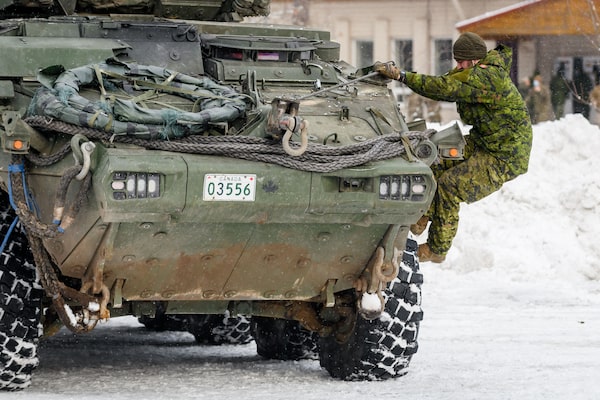
A military vehicle is pictured during a visit of Canada's Minister of Defence in Adazi, Latvia, on Feb. 3, 2022.GINTS IVUSKANS/Getty Images
Canada needs to set a date by which it will fulfill a NATO pledge to increase defence spending to 2 per cent of annual economic output, the military alliance’s secretary-general said Tuesday.
Jens Stoltenberg said Canada has yet to provide this date to the alliance.
“Canada has not conveyed a precise date but I expect Canada to deliver on the pledge to invest 2 per cent of GDP on defence, because this is a promise we all made,” Mr. Stoltenberg told CTV’s Power Play Tuesday.
He noted Canada is a Group of Seven member country with a big economy and the second-biggest land mass in the world and a huge coastline fronting the Atlantic, Arctic and Pacific Oceans.
“It really matters what Canada does,” he said, noting Ottawa’s commitment to spend billions on upgrading joint North American defences against airborne threats, its plans to buy new F-35 warplanes and its increased presence on NATO’s eastern flank in Latvia.
“All of this is good; all of this matters,” the civilian NATO leader said. “But of course, Canada should, as all other allies, deliver on the pledge to invest 2 per cent, because we need that in a more dangerous world.”
At a NATO summit last summer in Vilnius, Lithuania, all member countries including Canada signed a pledge to “make an enduring commitment to invest at least 2 per cent of our Gross Domestic Product (GDP) annually on defence.”
Canada has not spent 2 per cent on military spending since the late 1980s, including under former Conservative prime minister Stephen Harper. In the summer of 2023, NATO released estimates saying Canada was only spending 1.38 per cent of GDP on defence.
Mr. Stoltenberg said articulating a date for when a country will reach 2 per cent is important. “It matters to have a clear commitment on when to reach the 2-per-cent guideline,” he said.
Eighteen of NATO’s 31 members will reach the 2-per-cent mark in 2024, Mr. Stoltenberg said. Canada is not expected to be among them. Germany, for example, has embarked on a major increase in defence spending, partly because of a special €100-billion ($146-billion) fund established in response to Russia’s war in Ukraine.
Canada falls about $20-billion short in annual military spending when it comes to meeting its 2-per-cent commitment, according to David Perry, president of the Canadian Global Affairs Institute (CGAI).
“We expect that those who are not yet at 2 per cent should have plans in place to be there as soon as possible,” Mr. Stoltenberg said.
How much NATO nations are spending on defence became a flashpoint this month after former U.S. president Donald Trump suggested he would not protect countries that failed to meet the alliance’s spending targets, and would even encourage Russia to attack them.
A leaked Pentagon document obtained by The Washington Post last year said Prime Minister Justin Trudeau has told NATO officials privately that Canada will at no time meet the military alliance’s defence spending target. When this was reported last April, the Prime Minister declined to confirm he had made that statement.
Asked for comment on Mr. Stoltenberg’s remarks Tuesday, Defence Minister Bill Blair’s office referred The Globe to comments he made at a Toronto press conference Monday. There he was asked whether the need to help Ukraine defeat Russia could provide the impetus to increase defence spending and hit the 2-per-cent target while also providing more contracts and jobs for Canadians.
“I think it’s an important question and an important conversation for Canadians to have,” Mr. Blair said.
Defence spending has increased under the Liberals and the Department of National Defence’s budget is expected to more than double over 10 years to $39.7-billion in 2026-27 from $18.6-billion in 2016-17. Canada in recent years has committed to numerous major capital projects, including F-35 fighters, P-8 maritime patrol and reconnaissance aircraft, as well as nearly $40-billion over 20 years to modernize North American Aerospace Defense Command.
“Canada recognizes it must do more and I have said clearly and my government has said clearly, we will do more,” the Defence Minister said.
However, Mr. Blair said, “the challenge is not only getting more money from our budget into defence. It’s making sure that we produce good value for Canadians in those investments.”
With a report from Reuters